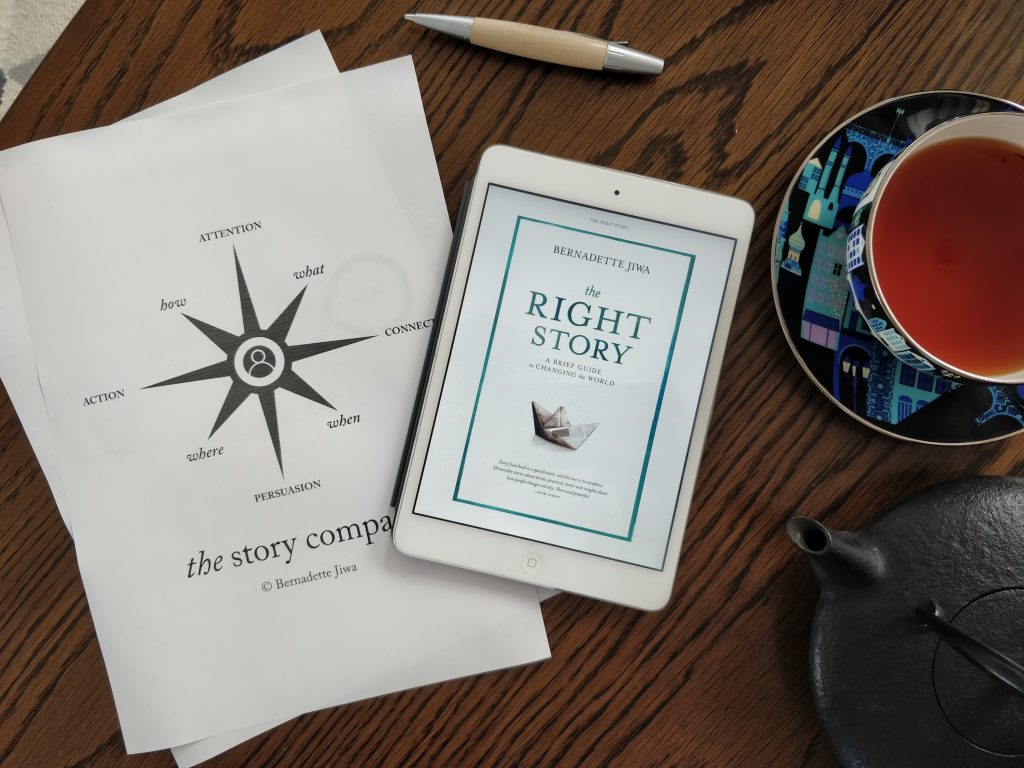Unlock the Magic in Your Story Now
Get the Free 20 questions to Ask Before Launching Your Idea workbook when you sign up for occasional updates.
Get the Free 20 questions to Ask Before Launching Your Idea workbook when you sign up for occasional updates.
Articles filed in: Storytelling
We Value What We Measure
filed in Storytelling, Strategy

One of my first jobs was working as the manager of a little Dublin cafe that stood at the intersection of two busy city streets. It was a lot of responsibility for someone in their late teens, and I loved it. There was something magical about opening the shutters first thing in the morning when it was still dark, then putting the lights and the coffee on, ready to welcome the first customers.
We saw the same faces every day. Office workers who grabbed a quick cuppa and a pastry on their way to work, builders who ordered soup or sandwiches for lunch. University students who nursed a cup of tea for hours while they read over their lecture notes in the afternoon.
It was a privilege to become part of customers’ rituals—to be welcomed into their life. We didn’t just exchange money for beverages and convenient snacks. We got to know people. We nourished them and became part of their story.
Our little cafe was the first branch in a chain of cafes, each with its own character and unique location. New branches opened each year. Oliver, the owner, did the rounds of them all. He visited us twice a day. During the lunchtime rush—to gauge the extent of the rush. And at the end of the day to count how much money was in the till. If the takings were up, he was happy. If they were down, his face grew dark, and he began to question why. As Oliver’s empire expanded the money consumed him. He found it hard to see past the coins and bills he could count at the end of the day and even more difficult to connect those totals with an ongoing business strategy. He grew less optimistic about succeeding and more worried about failing with every new branch he opened. Oliver became fearfully reactive to the marketplace instead of bravely responsive to our customers.
He began to cut corners and compromising on quality, ordering food from cheaper suppliers and hiring less staff. He raised prices without giving customers, who were now paying more for an inferior product and service, any notice or a reason. Soon the takings grew smaller as the lines thinned out and business slowed. The staff who had once loved working there left, as day-by-day our little gem of a cafe lost a bit more of its soul.
In a world where data is king, it’s more important than ever to remember that what we measure becomes the thing we’re compelled to act on. There’s nothing wrong with tracking our progress—it’s essential to help us decide on our ongoing strategy. But it’s important to look at progress from every angle, not just the most obvious and easiest one to measure.
Image by William Murphy
Worthy Of Your Marketing
filed in Marketing, Storytelling

When we’re planning a party, we know its success depends on the preparation we do in advance, often before the invitations are sent. Every detail, from the food to the table settings, the lighting to the music is carefully choreographed in anticipation of the guests’ arrival.
When we’re marketing, especially when we’re marketing online, we do the opposite. We spend the majority of our time working out how to get people to the party (our website, podcast or blog), and not enough time giving them a reason to stay once they get there.
The products, services and online experience you’re crafting for your customers need to be worthy of your marketing. Throw a party that’s worth coming to.
Image by gomagoti
The Loyalty Department
filed in Storytelling, Strategy

My mum, (who is in her late seventies) wanted to negotiate the renewal of her internet and phone contract. She dialled the customer support number listed on her bill and was placed on hold for 30 minutes. When she finally got through to a human being, she was transferred to the ‘loyalty department’. She waited on hold for a further 40 minutes before being connected to someone who could help her. The duration of the call was 1 hour 37 minutes and 26 seconds.
This company and other internet service providers are competing on price. Customers see new, cheaper service bundles advertised and are tempted to switch because the pain of switching is outweighed by the savings they will make. Customers no longer see the benefit of sticking with the company they’ve previously been loyal to unless that company price matches its competitors—which is inevitably what happens when existing customers pick up the phone. Customers who persist with the unacceptable call wait times get a better deal. If the loyalty department speaks to too many customers who want to renegotiate their contract, that affects the company’s bottom line.
We spend more resources to woo new customers than we do to earn the continued loyalty of the customers we already have. When the quality of what we sell or serve is barely distinguishable from that of our competitors, we must find other ways to differentiate. One of those ways is by being true to our customers and having a ‘loyalty department’ that lives up to its name. Loyalty shouldn’t only benefit the company—it should work both ways.
Image by Mabel Amber
The Distinction Between Needs And Wants
filed in Marketing, Storytelling

When we visit the doctor with a health problem, we are keen to have our immediate needs met. Perhaps we need pain relief or a blood test. Maybe we need a diagnosis and treatment. But alongside the desire for a physiological solution is the yearning for our intangible wants to be fulfilled. We need treatment, and we want empathy. A good doctor treats us—a great doctor makes us feel better. We value the great doctor’s ability to do both.
Things are no different when it comes to other experiences in our lives. Our hunger is satisfied when we eat the meal we ordered, but we enjoy the food more when the service exceeds our expectations.
There may be little room to differentiate your product or service based on customer needs, but the ability to differentiate on their wants is exponential. It’s possible to meet needs and wants in every interaction. How are you doing that?
Image by NYC Health
Bridging The Change Gap
filed in Marketing, Storytelling, Strategy

We know that attention is the first essential step on the path to influencing others. We also know it’s not possible to inspire people to act or to create change with attention alone. There’s always a gap between gaining awareness, enabling action and gaining traction. You can buy attention, but you can’t buy trust. Trust is earned. Trust takes time. Trust is the enabler of connection and persuasion. The time between attention and action is what I call the Change Gap. To close this gap, we must first build trust and then reinforce the opinions and beliefs of the audience we’re trying to reach.

We bridge this gap with connection and persuasion. This is why for example, a hotel’s reviews on websites like TripAdvisor can make or break the business. When every hotel has a comfortable bed and free Wi-Fi, prospective guests are looking for another way to differentiate offerings, and reviews enable them to do that.
The act of persuasion gives people the opportunity to confirm whether what they believe is true. Things like providing more and accurate information, product features, measurements, photographs, pricing, demonstrations, reviews or recommendations help people to decide if your product or service is for them.
There are many real-world examples of companies who have successfully bridged the Change Gap, and industries that have been spawned by doing so. Think about the products and services we didn’t know we wanted but now consume or use regularly. Bottled water, ride-sharing services, reusable coffee cups, coworking spaces, bean-to-bar chocolate, yoga pants, nail bars, coconut oil and meal kits are just a few. The people and companies who convinced so many of us to try these products and services bridged the Change Gap by being purposeful storytellers. The same opportunity is open to you.
*Excerpted from The Right Story.
Image by Garry Knight
Introducing The Story Compass
filed in Marketing, Storytelling, Strategy

My new book, The Right Story publishes today. I can’t wait to hear how you’re using the new tools in the book to help you craft your messaging and engage more deeply with your customers. The Story Compass is one of those tools in the book. It’s designed to facilitate powerful, purposeful storytelling. It will help you to clarify what’s driving your story at any given time, and to consider how best to deliver your message as a result.

Using The Story Compass, together with the accompanying questions in the book will give you a better understanding of the change you’re trying to create, for whom, and help you tell the right story to achieve it. It enables you to define your story strategy and design your tactics. Before you begin to craft your message, you need to decide if the purpose of that message is to get attention or to deepen trust and connection. Is it to empower people to be open to persuasion or to act?
Once you know why you’re telling the story you can begin to work on how to best tell it. The tactics you use to get your message across are the how of your story—the means by which you carry out your strategy. What you say and do, when and where, has an impact on where you end up. A message that resonates relies on the communicator discerning the most e ective way to deliver it.
The clarity with which you show up, as only you can, changes how the story is told and with whom it resonates. How you go about your work can have just as much impact on your results as the work itself.
The Right Story is my invitation to you to think about the impact of the work you’re here to do and the skin you want to get under, the hearts you want to touch and the lives you want to make better.
Thanks for giving me a reason to write it.
Be A Powerful And Purposeful Storyteller
filed in Marketing, Storytelling, Strategy

*The following post is an extract from my new book The Right Story.*
Throughout history, the technology of the day has always influenced how its users communicate and share ideas. How we think about spreading ideas is shaped by the resources available to us. How we connect and persuade is affected by the way we choose to deliver the message. When we’re face-to-face, we gesture and embellish. When we’re tweeting or texting, we use emoji and cut to the chase.
Our behaviour isn’t the only thing that changed over time. A subtle change in our mindset simultaneously took place too. We began to focus less on the drivers of change—the reasons behind those interactions we initiated. And we started to prioritise the immediate benefit we wanted to get from the interaction. We neglected to build trust before sharing the message and instead obsessed over just delivering it. The result is that we have changed from purposeful storytellers, who care about how the audience or user feels, to pragmatic communicators who prioritise ‘getting the word out there’ so we can persuade people to act.
The problem with just homing in on the mode of delivery is that technology is constantly changing. No sooner have you conquered the Facebook marketing landscape than the algorithm changes. One minute it seems that print is dead; then suddenly the tangible is having a revival. The answer then, is not to get too preoccupied with adapting your message to suit the changing technology of the day, but to focus on what’s unchanging about people instead.
Where should your story begin? There’s a tendency to dedicate the bulk of our resources—time, energy and money—to the delivery of our messages. But effective storytelling happens in two parts. Purposeful storytelling is a combination strategy and tactics —drivers and delivery.

You must define your strategy before you begin designing and deploying tactics. You have to know who you want to influence and why—to be clear about what’s driving your story, before you consider what, where, when and how you’re going to deliver the message to those people you hope to reach and change. Starting with the why is important because if we focus only on the how, the delivery, then our stories fall flat, and we are less likely to create the change we hope to make.
We’ve come to a crossroads in sales and marketing. We have two choices. We can be fearfully reactive to the marketplace or bravely responsive to our customers. We can carry on doing what we’ve been doing since the golden days of advertising and the Madison Avenue era. We can spend more money interrupting more people in physical and digital places—with the intention of finding the quickest route from getting everyone’s attention to making a tiny percentage of people act. Or we can find a group of people we want to serve, people with a need or a desire we care about fulfilling, and earn their trust and loyalty over time. We must choose whether we want to make weak ties by going broad and shallow, or strong ties by going narrow and deep. We need to decide if we want to be the loudest or most resonant, most visible or most memorable. We can’t be both.
Image by Garry Knight
Is Your Marketing Working?
filed in Marketing, Storytelling, Strategy

Last week I visited the local camping store to buy a gift card. As I was paying at the point of sale, a one question survey popped up on the keypad. The store manager asked if I’d seen their TV ad. When I said I hadn’t, she hit ‘no’ on the survey. I couldn’t resist asking her what percentage of people said ‘yes’. In her store, the answer was zero. In the time they’d been doing this survey the store manager hadn’t encountered a single paying customer who had seen the company’s TV ad. Not one.
Their marketing (or I should say, their advertising) isn’t working. And yet, the store was full of people buying tents for their camping trips down south, and warm jackets for their overseas skiing trips. The TV adverts are seen by hundreds of thousands of people. The problem is that those ads aren’t being seen by the right people. The camping company has discovered that more reach doesn’t equate to more resonance or more of the right customers.
Making more people aware that your product or service exists doesn’t mean your product or service will be more successful. It’s not enough to tell your story. You need to tell the right story to the right people at the right time.
The tools in my new book, The Right Story, now available for pre-order will show you how.
Image by Thomas Rousing
The Right Story
filed in Marketing, Storytelling, Strategy

What makes some bad ideas successful, and why do many good ideas fail? It turns out that there’s no such thing as a bad idea or a good idea. There is only the wrong story or the right story. The right story is one that is trusted. It is believed because it is told by the right person, for the right reasons, in the right way, at the right time, to the right people.
The success or failure of our ideas depends on us telling the right story. We can only do that by being clear about the change we want to create, and why—and then bringing enough of the right people with us on the journey. It’s up to us, the changemakers of today and tomorrow, to galvanise those people we hope to bring on the journey with us.
That’s why I wrote my new book, The Right Story. Not just to help you to persuade people or get better at delivering your message. But also to give you the tools to help you understand what should drive that message.
The Right Story will help you to resonate with your right people and become a more purposeful and powerful communicator. You’re the reason I wrote it. You can preorder your Kindle copy today—paperback copies will be available next week. I hope it helps you and your good ideas to succeed this year.
